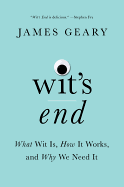
In books about aphorisms (The World in a Phrase) and metaphor (I Is an Other), James Geary has demonstrated he's someone who admires an elegant turn of phrase. He mines a similar lode in Wit's End, an entertaining exploration of how intellectual dexterity manifests itself in both verbal and visual form.
From the beginning of this brief but wide-ranging survey, Geary explains that true wit is about much more than the ability to tell a good joke or a humorous story. His working definition of the term--"the faculty of mind that integrates knowledge and experience, fuses divided worlds, and links the unlike with the like"--sums up his belief that true wit is much more than merely being funny, something "richer, cannier, more riddling."
That thesis is best illustrated in Geary's discussion of puns. Though most people have been taught to regard this form of wordplay as the lowest form of humor, Geary has a particular affinity for the talent it takes when one "folds a double knowledge into words."
He also shows off some of his own cleverness in style--or, more accurately, the multiplicity of styles he's chosen here. Between the opening chapter and the acknowledgements--both written in the manner of Alexander Pope's rhymed couplets--he plays with a variety of literary forms.
In Wit's End, James Geary is undaunted by the risk anyone writing about the subject of being funny takes: spoiling the joke by explaining it. Refreshingly, he shows here that he's fully equal to the task, enhancing our appreciation of how true wit can both amuse and enlighten. --Harvey Freedenberg, freelance reviewer

